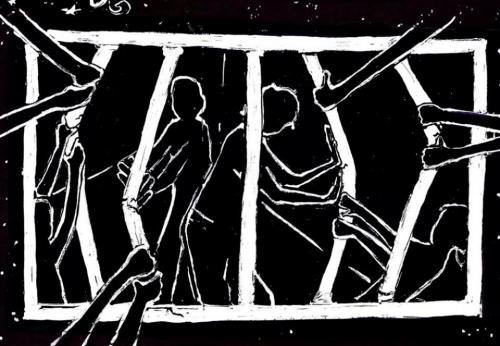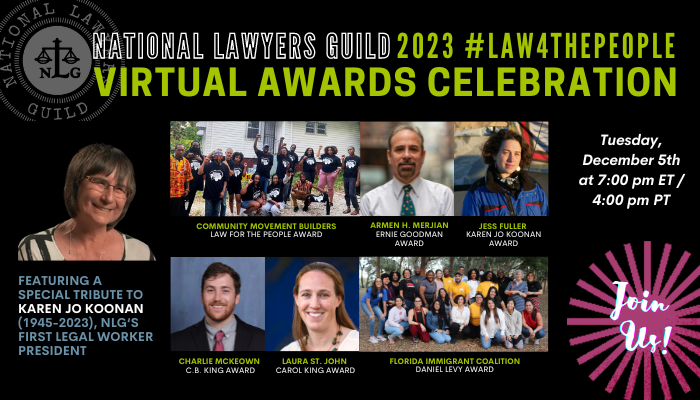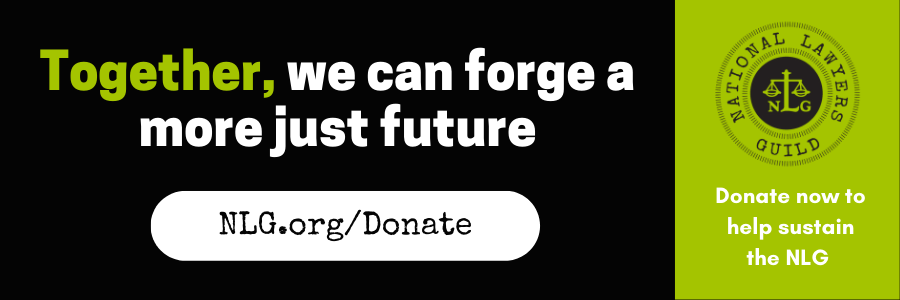Lisa Drapkin, NLG Membership Director
It seems there could never be enough legal support to help the millions of prisoners who would benefit from having a lawyer at arms’ length. Whether it is lack of medical care, abhorrent nutrition, exposure to extreme temperatures, lack of clean water, or brutality by prison guards, there are endless inhumane conditions prisoners are forced to live through on a daily basis. The National Lawyers Guild’s National Office receives letter after letter from prisoners, mainly requesting a copy of the Jailhouse Lawyers Handbook (a resource for prisoners who wish to file a federal lawsuit addressing poor conditions in prison or abuse by prison staff), but many also hope that they can obtain help from a lawyer to stand up against the prison administration on their behalf. One of the reasons why there are not more lawyers to help prisoners with civil suits is because of the Prison Litigation Reform Act (PLRA).
The PLRA is a federal law that was enacted in 1996 under President Clinton. Congress enacted the law in response to a significant increase in prisoner litigation in the federal courts. A misconstrued case was supposedly the impetus for the PLRA coming about, one in which a prisoner filed suit over receiving crunchy peanut butter instead of creamy. However the facts of this case were incorrect, and instead it was about a prisoner not receiving a refund for a jar of peanut butter he returned. This is extremely legitimate because the majority of prisoners have little to no funds to their name. As the Jailhouse Lawyers Handbook states, “Many people say Congress believed a story that was told to them by states tired of spending money to defend themselves against prisoner lawsuits. In this story, prisoners file mountains of unimportant lawsuits because they have time on their hands, and enjoy harassing the government. The obvious truth – that prisoners file a lot of lawsuits because they are subjected to a lot of unjust treatment – was ignored.”
According to the PLRA, before prisoners are allowed to challenge a condition of their confinement in federal court, they must first exhaust available administrative remedies by pursuing to completion whichever grievance or appeal procedures the prison administration provides. Even a lawyer cannot do anything until the individual goes through several bureaucratic layers. This can be very difficult. The author of an article titled Another Clinton-Era Law That Needs to be Repealed, puts it well: “Imagine a prisoner who is in pain and in need of medical treatment, but ignored by prison staff: She must not only file her complaint with the same staff that is denying her treatment, but wait for a refusal, appeal that decision, and only after a judgment on that appeal can she then file a legal case beyond prison walls.” To further this sentiment, a New Yorker article from May 2016 called, Why It’s Nearly Impossible for Prisoners to Sue Prisons states, “Around half of all prisoners in the United States have some sort of mental illness, and a similar proportion has only basic literacy skills (at best), but courts have frequently ruled that neither mental illness nor illiteracy excuses an inmate from the exhaustion requirement of the PLRA. Juveniles are not exempt, either.” The article cites an example in which a teenager filed a lawsuit stating that he was repeatedly raped and beaten by other prisoners who were following what guards told them to do. The suit was dismissed because the teen didn’t file a formal grievance first, even though his mother contacted prison officials.
It is extremely common for a prisoner to experience retaliation by guards for even filing a grievance or helping others to do so. When asking NLG jailhouse lawyer members what their experiences are like doing legal work behind bars, responses ranges from Correctional Officers throwing out completed grievance forms in front of prisoners, to being thrown in solitary confinement or being transferred to another prison. Another problem is that even if staff were following the rules, there wouldn’t be enough of them to handle all the complaints. As one prisoner in Michigan wrote, “The sad truth is that prisoners often have a difficult time obtaining adequate administrative remedies through the grievance system. Largely because staff within our institutions responsible for investigating grievances are often overwhelmed with grievances.” What’s more, prisoners cannot file a lawsuit for mental or emotional injury without also showing physical injury, which can lead to abuse to occur without any accountability. At least in 2013, with the Violence Against Women Act, the PLRA was amended to include sexual assault as well even if physical injury is not medically apparent. In addition to all of this, the PLRA limits the court’s ability to make prison officials pay for attorneys’ fees if a case against them is won – which means there is no monetary incentive for lawyers to take these cases.
If the PLRA were repealed, it would be an important step towards allowing prisoners to hold prison administrations accountable for their collective actions or neglect. There would perhaps be a more level playing field, and prisoners might gain a greater sense of dignity having a legal method of recourse be more attainable. There also might be more lawyers willing to represent prisoners in civil suits if they could expect to be compensated for their work. Currently though, jailhouse lawyers face a steep uphill battle when it comes to fighting for the rights of themselves and other prisoners.
Despite the many hurdles they face, the jailhouse lawyer members of the National Lawyers Guild take their efforts very seriously and are proud of the skills they have gained, especially when it comes to being able to help others. To give some examples, here are just a few of the sentiments that jailhouse lawyers in various states across the country have shared with us:
“I’ve been helping a paraplegic in a lawsuit for nearly 3 years now. When he came to this unit, they were not up to code to house a paraplegic in a wheelchair. So grievances were filed under the ADA. After it was filed, he injured himself trying to take a shower. He fell out of a regular plastic chair. Now, the unit has added accommodations for wheelchairs and installed chair seats in the shower for them, but a little too late in his case. We’ve forced them to remodel the recreation yard’s restroom facility so that inmates with wheelchairs can use it. I am expecting good things from a related case that will help other inmates in the future while here.”
“From the moment I first helped someone with the most minor appeals process, and I saw the hope come alive in their face, I knew I would be a Jailhouse Lawyer. We have to fight. We have to hold those accountable who hold us captive. We must speak out at every opportunity, and demand every single right. We must remember that practically every single right we have in prison is because some JL filed on it. So next time you get free soap, or help from a law library, or an extra hour on the b-ball court, spare a thought for the unsung hero who made that happen for you, and every other inmate.”
“It is extremely stressful at times considering the limited and outdated materials we have, but once all the facts and other necessary information is gathered together it is satisfying to prepare the motions, writs, etc. and I feel an immense joy when something positive happens for the person I’ve helped. Helping people here in this prison gives me a sense of pride and a rewarding feeling. Two sensations I have not felt in many years. I now have a sense of fulfillment and joy from partaking in something that I had always thought was difficult and boring.”
When we move from the individual to creating change on a larger scale, making noticeable improvements in prison conditions requires not only legal recourse but also an organized resistance. As the Jailhouse Lawyers Handbook states, “Only a strong prison movement can win and enforce significant legal victories. But the prison movement can also use court action to help build its political strength.” A good example of this is the California Hunger Strike of 2013.
The initial coordinated CA hunger strike was in 2011, when over 12,000 prisoners and their family/community members participated in statewide hunger strikes protesting the inhumane conditions in the SHU (Segregated Housing Unit). Following the strike, their demands for reform had not been met, and so another coordinated hunger strike was held in 2013, involving 30,000 CA prisoners. The strike even spread to prisoners in other states and in other countries. There were many outside calls for solidarity, and news of the largest hunger strike in history brought a large amount of attention to mainstream media and therefore also the public at large.
Simultaneously, Ashker v. Governor of California, brought about by the Center for Constitutional Rights (CCR) starting in 2012, was a federal class action lawsuit on behalf of prisoners held in the SHU at California’s Pelican Bay State Prison who had spent a decade or more in solitary confinement. The focus of the suit was that prolonged solitary violates the Eighth Amendment’s prohibition against cruel and unusual punishment. The suit also charged that prisoners are denied any meaningful review of their SHU placement. California imposed extremely prolonged solitary confinement based merely on a prisoner’s alleged association with a prison gang. Gang “affiliation” was assessed without considering whether a prisoner is – or ever was – actually involved in gang activity. The named plaintiffs included several leaders and participants from the hunger strikes.
In 2015, the plaintiffs and the State of California agreed on a landmark settlement that ended the use of indeterminate solitary confinement in prisons across CA as well as the use of “gang affiliation” as a basis for placing people in isolation. Several other key reforms were made, all related to the use of solitary. The weight of the resistance movement in conjunction with the courtroom battle was necessary in order for such a meaningful result to occur. As the plaintiffs stated, “This settlement represents a monumental victory for prisoners and an important step toward our goal of ending solitary confinement in California, and across the country. California’s agreement to abandon indeterminate SHU confinement based on gang affiliation demonstrates the power of unity and collective action. This victory was achieved by the efforts of people in prison, their families and loved ones, lawyers, and outside supporters.”
Unfortunately, two years after the settlement, CCR found many violations taking place. As they stated in November 2017, “Two years later, California has failed to make the requisite reforms to bring their prisons into compliance with due process.“ The violations included hundreds of prisoners formerly held in SHU being transferred to Level IV prisons where conditions were very similar to SHU. Because a legal settlement did not provide instant relief for all, coordinated efforts to resist solitary confinement from the inside and the outside are still needed. For example, groups like the Prisoner Advocacy Network (PAN) of the National Lawyers Guild’s San Francisco Chapter seek to strengthen these efforts by providing advocacy for activists on the inside. As their website states, “Following California hunger strikes, loved ones of people suffering from solitary confinement alerted the NLGSF to the need for individualized advocacy. Though a recent settlement agreement in the Ashker v. Brown suit will result in many transfers, we know CDCR will continue to deny appropriate care and conditions, involuntarily segregate, mistreat, and retaliate against people.”
Whether on an individual or large-scale level, attempts to use legal recourse as a path toward better prison conditions will face many obstacles. Of course, there are other approaches that do not involve the law, as seen by recent prison riots and uprisings, including the largest coordinated prison strike in US history in September 2016, which included the Kinross Rebellion by Michigan prisoners. There was also the Delaware Vaughn Rebellion in February 2017, and countless other examples from last year alone. Members of the Prisoners Legal Advocacy Network of the NLG New Jersey/Delaware Chapter gathered information about the severe repression prisoners faced in the aftermath of some of these protests. A planned strike in Florida prisons will begin starting on Martin Luther King Day of 2018. Florida prisoners withstand brutally repressive conditions by guards with no recourse, as prisoner and activist Kevin “Rashid” Johnson explained: “On a literal daily basis prisoners are gassed, tortured and/or brutally beaten by guards with the full complicity of medical and mental health staff. As part of this culture of abuse, grievance officials routinely trash prisoners’ attempts to grieve their mistreatment. This is to eliminate any records of the abuses and to frustrate any potential attempts at litigation.” On top of this, demands of the strikers include receiving actual payment for their labor and an end to the price gouging that occurs because prisoners pay exorbitantly higher amounts for items in the prison commissary than they would on the outside.
Legal advocates should not lose sight of chipping away at least the most unjust parts of the PLRA as a goal. Although despite the barriers, it’s clear that prisoners – from jailhouse lawyer to strike organizer – have found ways to fight for the humanity they deserve. In turn, they will continue to need as many outside supporters in solidarity as they can get.
The NLG is the only bar association that admits jailhouse lawyers as members, and does so at no cost to incarcerated members (dues are waived). To become a NLG member, jailhouse lawyers may write to the NLG at NLG, 132 Nassau St., Rm. 922, New York, NY 10038.




